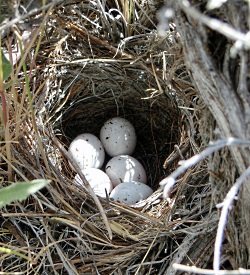
Courtesy & © Copyright
Jim Cane, Photographer
Living organisms are impelled to maximize the number of successful offspring they produce. Therefore, they tend to reproduce during times of plenty, because the breeding season is strenuous. Males compete for mates and territory and females produce eggs. Both parents may guard the nest from predators and feed the young. Many birds feed nutrient rich insects to their nestlings so nesting season is timed to coincide with the greatest abundance of insects, usually spring in temperate and arctic climes.
American and Lesser Goldfinches are one example of birds who do things differently. (Lesser Goldfinch. Kevin Colver: Songbirds of the Southwest Canyon Country) Instead of insects, they feed their young a regurgitated milky seed pulp. Therefore, they time their nesting for greatest abundance of seeds, especially sunflower and thistle, which is in the summer.
Other birds prefer one type of nut. These include Pinon Jays and crossbills. Abundant pinon nuts trigger Pinon Jay nesting. (Pinon Jay. Kevin Colver: Songbirds of the Southwest Canyon Country) If they have enough nuts cached from the previous season, they will nest in late winter, even while snow blankets the landscape. In years with a bumper crop of pinon nuts, they will also breed in late summer to take advantage of the plentiful food. Good conifer cone crops determine when and where crossbills nest, which can be almost any time.
Great-horned Owls are one of the first to nest each year. (Great-horned Owl. Kevin Colver: Songbirds of the Southwest Canyon Country) You can hear courting pairs hoot back and forth in midwinter. They may incubate their eggs while covered in snow, and if the temperature is too frigid, the eggs freeze and the young die. Many predatory birds nest early, perhaps to insure that the young learn how to proficiently hunt before winter.
The drive to reproduce is inviolable and birds take advantage of whatever season gives them the greatest chance for success. For every nesting bird there is a season.
Thanks to Kevin Colver for the use of his bird recordings.
This is Linda Kervin for Bridgerland Audubon Society and Wild About Utah.
Credits:
Images: Jim Cane, Bridgerland Audubon Society
Audio: Courtesy & © Kevin Colver https://wildstore.wildsanctuary.com/
Theme: Courtesy & Copyright Don Anderson as performed by Leaping Lulu
Text & Voice: Linda Kervin, Bridgerland Audubon Society
Additional Reading:
Linda Kervin’s pieces on Wild About Utah
Red Crossbill, All About Birds, Cornell Lab of Ornithology, Cornell University, https://www.allaboutbirds.org/guide/red_crossbill/lifehistory
Great Horned Owl, All About Birds, Cornell Lab of Ornithology, Cornell University, https://www.birds.cornell.edu/AllAboutBirds/owlp/ghowl
American Goldfinch, Spinus tristis, Guide to North American Birds, National Audubon, https://birds.audubon.org/birds/american-goldfinch
Erlich, Paul, Birders Handbook, Touchstone/Simon & Schuster, June 15, 1988, https://books.simonandschuster.com/Birders-Handbook/Paul-Ehrlich/9780671659899
